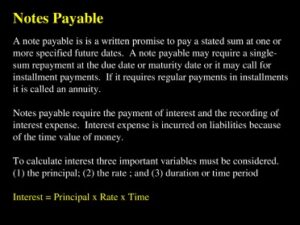Content

Understanding the reporting of long-lived assets at inception requires distinguishing between expenditures that are capitalised (i.e., reported as long-lived assets) and those that are expensed. Once a long-lived asset is recognised, it is reported under the cost model at its historical cost less accumulated depreciation and less any impairment or under the revaluation model at its fair value. IFRS permit the use of either the cost model or the revaluation model, whereas US GAAP require the use of the cost model. The choice of different methods to depreciate long-lived assets can create challenges for analysts comparing companies. Then, allocates the excess of the impairment loss to other assets of the unit on a pro-rata basis based on the carrying amount of each asset in the unit.
Institutions should consider whether internal policies, including those referencing existing supervisory guidance, need to be updated or modified for the new accounting standard. One conceptual problem with this approach is that the carrying value of the asset may not always reflect the underlying economic value to the company. By not testing for impairment every year, it is possible that an asset that is becoming impaired incrementally may not be properly adjusted until the impairment is quite severe. Once the impairment is recorded, the inability to reverse this amount if future circumstances improve means the asset’s economic potential is not properly reflected on the balance sheet. Although there are problems with this approach, it can be argued that annual impairment testing for all assets is a time-consuming and costly exercise.
When do we know we need to impair an asset or a CGU?
The above now summarises the key principles for impairment of assets. The standard provides more detailed guidance and explanation on the key principles. In practice, there are lots of significant judgments Time To Reverse Impairment Losses On Non and estimates involved in this area. Entities do not need to figure out both fair value less costs of disposal and VIU. For example, if either one of these amounts exceeds the asset’s carrying amount.

The noncredit discount is accreted into interest income over the life of the PCD financial asset on a level-yield basis . The agencies will not require institutions to undertake efforts to obtain or reconstruct data from previous periods that are not reasonably available without undue cost and effort. However, an institution may decide it would be beneficial to do so to more effectively implement CECL. An institution may find that certain data from previous periods relevant to its determination of its historical lifetime loss experience are not available or no longer accessible in the institution’s loan system or from other sources. The institution should promptly begin to capture and maintain such data on a go-forward basis so it can build up a more complete set of relevant historical loss data by the effective date of the new credit losses standard or as soon thereafter as practicable.
About the IFRS Foundation
Intangible assets with a limited-life are amortized on a straight-line basis over their economic or legal life, based on whichever is shorter. Examples of intangible assets with a limited-life include copyrights and patents. Only intangible assets with an indefinite life are reassessed each year for impairment. For CGUs, the impairment loss is allocated to goodwill first, and then to the rest of the assets pro rata on the basis of the carrying amount of each asset (IAS 36.104).
- Except, if the asset does not generate cash inflows that are largely independent from other assets or groups of assets.
- A historical cost is a measure of value used in accounting in which an asset on the balance sheet is recorded at its original cost when acquired by the company.
- Corporate assets are assets other than goodwill that contribute to the future cash flows of both the CGU under review and other CGUs.
- Under US GAAP, investment properties are generally measured using the cost model.
- A failure to maintain, analyze, or support an appropriate ACL in accordance with U.S.
- In this case, because the undiscounted cash flows exceed the carrying value, no impairment is present, and no further action is required.
If there is an indication that an impairment loss has reversed, then a company is required to estimate the recoverable amount of the previously impaired asset or cash-generating unit . In estimating the recoverable amount, a company needs to reassess and recalibrate its assumptions to reflect the outlook for the future of the company’s assets as at the reporting date. Early application of the new credit losses https://kelleysbookkeeping.com/ standard is permitted for all institutions for fiscal years beginning after December 15, 2018, including interim periods within those fiscal years. The expected future cash flow estimation is based on a number of factors, variables and assumptions, the most important of which are estimates of reserves, future production profiles, third party supply, commodity prices, costs and foreign exchange rates.
Allocation of impairment losses
Thus, for a non-PBE with a calendar year fiscal year, the standard is effective January 1, 2022, and the entity must first apply the new accounting standard in its financial statements and regulatory reports (e.g., the Call Report) for the quarter ended March 31, 2022. When developing estimates of expected credit losses on financial assets, the institution should consider available information relevant to assessing the collectability of cash flows. This information may include internal information, external information, or a combination of both relating to past events, current conditions, and reasonable and supportable forecasts.

Compare the financial reporting of investment property with that of property, plant, and equipment. We will continue our discussion on other financial reporting requirements in our future articles. Market interest rates or other market rates of return on investment have increased and those increases are likely to affect the discount rate used in calculating an asset’s VIU and decrease the asset’s recoverable amount materially. Significant changes with an adverse effect have taken place or will take place in the near future on the entity, in the technological, market, economic or legal environment in which the entity operates or in the market an asset is dedicated.
How to Handle Impairment of Assets the Right Way
An institution will continue to account for a modification as a TDR if the institution for economic or legal reasons related to a borrower’s financial difficulties grants a concession to the borrower that it would not otherwise consider. However, the FASB determined that credit losses on TDRs should be calculated under the same expected credit loss methodology that is applied to other financial assets carried at amortized cost – in other words, under CECL. This is in contrast to current guidance, which requires that impairment on loans that are TDRs be measured using specific methods applicable to individually impaired loans (e.g., discounted cash flow and fair value of collateral). However, inputs will need to change in order to achieve an appropriate estimate of expected credit losses. For instance, the inputs to a loss rate method would need to reflect expected losses over the contractual term, rather than the annual loss rates commonly used under the existing incurred loss methodology. For a PBE that is not an SEC filer, the credit losses standard is effective for fiscal years beginning after December 15, 2020, including interim periods within those fiscal years.
What is reversal of impairment loss as 28?
Reversal of Impairment Loss
If the recoverable amount of the asset is more than the carrying amount, then the impairment loss has to be reversed and it has to be treated as income in the books of accounts.
